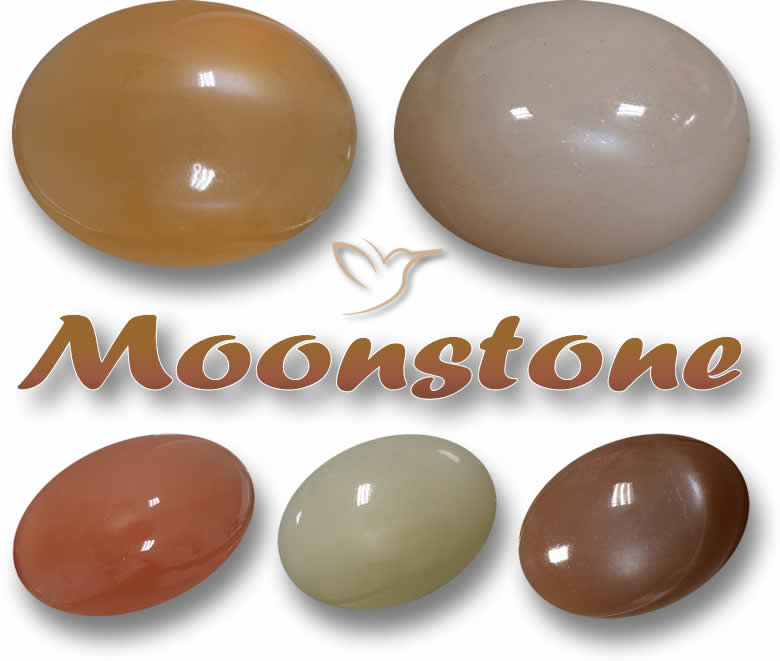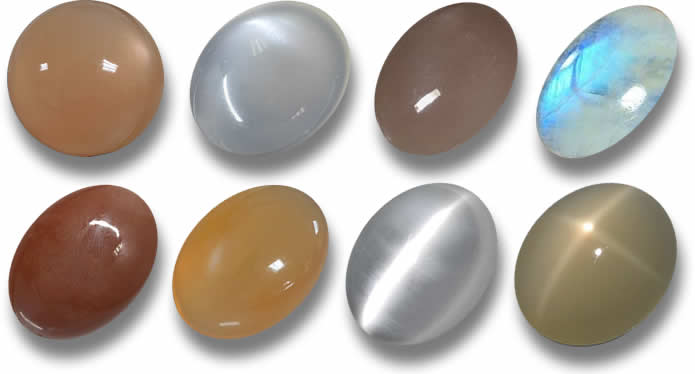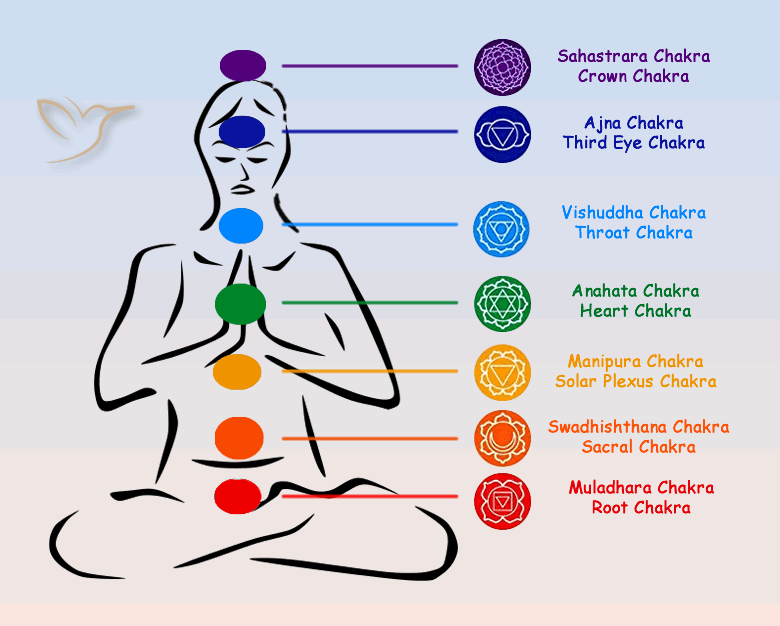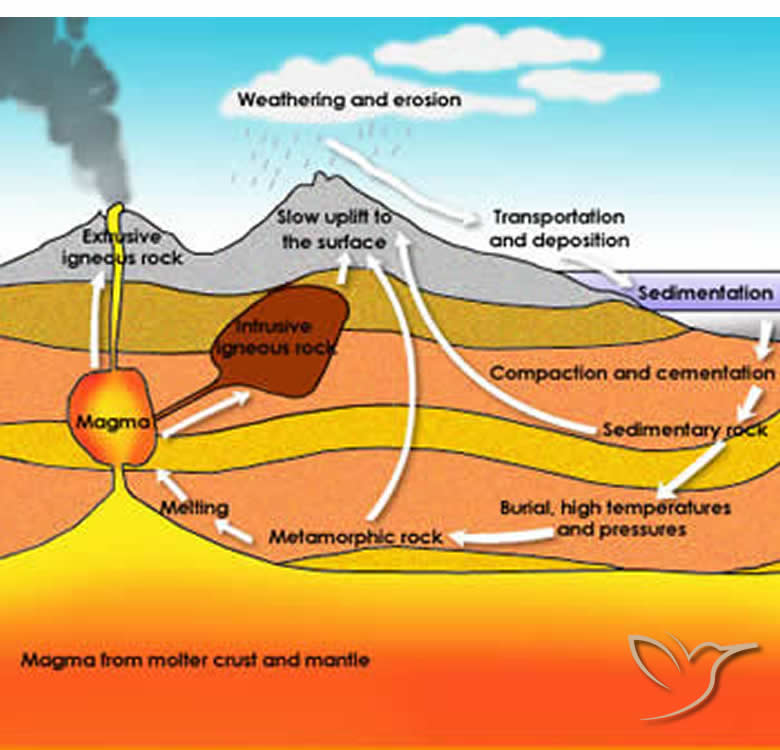What can I find in this article?
- Moonstone Colors
- Moonstone Species
- Moonstone Clarity and Cut
- What is the spiritual meaning of Moonstone?
- Moonstone and the Chakras
- Health Benefits of Moonstone
- Moonstone Price
- Moonstone Discovery and History
- Did you know? Interesting facts about Moonstones
- Where is Moonstone found?
- How is Moonstone formed?
- Can Moonstone be treated?
- What Jewelry is Moonstone suitable for?
- How to care for Moonstone
- How can you tell a real Moonstone?
- Can Moonstone change color?
- What is so special about Moonstone?
- Moonstone - Gemological Properties
Moonstone Gemstone Information

Introduction
Let's forget the science for a moment and look at a Moonstone through the eyes of an Ancient Egyptian, Greek or Roman. The glow from inside, the light that catches a flash of color, the silky surface that seems almost liquid, is it any wonder that they thought this gemstone originated in the rays of the moon?
The Schiller effect, adularescence, light interference, lamellar crystal formation, these are some of the scientific explanations for the way Moonstones gleam. But surely saying they are frozen moonbeams filled with joyful spirits is so much nicer (and a lot simpler!).

Unlike most gemstones it is not entirely the color of a moonstone that determines the value of a Moonstone.
Moonstones are valued on the glowing sheen that seems to float on their surface. A clear, colorless body allows this effect to be displayed at its best. Moonstones come in white, gray, pink, yellow, orange, brown and red colors, each with their own natural beauty but it is the gloss or shimmer that appears to be almost liquid on the surface that creates value.
The base color of Moonstones is caused by mineral impurities that mixed with the Silicon and Aluminum chemicals as the crystals were being formed. The variety of chemicals and minerals that were combined by intense heat from erupting magma were, for some time, molten rock.
After the volcanic activity ceased the rocks began to cool and harden and, as they did so, the minerals separated into thin layers. Later as gemstones, the light that hits these thin layers gets deflected and reflected which is displayed as shimmering colors. The thinner the layers, the rarer it is and the more blue the color. This blue color is most often seen in the Rainbow Moonstone which is actually a form of Labradorite but generally considered a type of Moonstone.
Moonstones are a type of feldspar, the most plentiful mineral on earth, a mixture of silica and aluminum which makes up more than half of the Earth's crust. Geologist may be upset here but the physical make-up of the gemstone is not as important as the beauty of its glowing luster.
Moonstones are technically known as an Orthoclase Feldspar (try selling that in a jewelry store) and the name Moonstone is just a trade name for the gemstones which display the shimmer and gleam known as adularescence.
Rainbow Moonstone is a variety of Labradorite which has a shimmering or iridescent quality so similar to Moonstone that they are considered to be the same gemstone. Labradorite, Sunstone and Amazonite have very similar chemical compositions and are also types of feldspars.

A rare, but popular, variety of Moonstone, is the Cat's Eye or Star Moonstones where inclusions within the gemstone reflect a thin band of light resembling the eye of a cat or, less commonly, a star of 4 or 6 or even more rays. This optical phenomenon on top of the moon-like glow makes a fascinating gemstone.


Gemstones usually fall into one of three categories of clarity with variations within that category. Opaque gemstones do not allow any light to pass through even if you hold it up to a light source. Translucent gemstones allow some light to shine through but you cannot clearly see through the gemstone. Transparent Gemstones allow light to pass through uninhibited so you can look through them and see objects or read words on the other side.
Technically, Moonstones can be described as translucent to transparent and the more transparent they are the more valuable they become. Inclusions can interfere with the effect of the gemstone's adularescence so the fewer the better. A characteristic Moonstone inclusion is called the centipede as it resembles one of the many legged creatures.
Moonstones are nearly always cut into oval- and circle-shaped smooth domes or cabochons as it best shows off the shimmering glow. The adularescence is usually stronger in one direction so the cutter needs to examine the gemstone carefully to determine which way to cut and polish the Moonstone.
With its ethereal or heavenly looks it is no wonder that Moonstone is surrounded by mythology and spiritual energy. In the ancient world from east to west, these gemstones were believed to fall from the sky and the magical shimmering display does hint at supernatural origins.
Moonstone's obvious association with the moon itself has lead it to be often seen as possessing feminine powers such as intuition, creativity, nurture and unconditional love.
The variety of minerals that go into the creation of this gemstone affects the spiritual influences from gemstone to gemstone. The Star and Cat's Eye Moonstones are special cases and Rainbow Moonstone is really a Labradorite so discovering their powers can get a bit fuzzy.
One of the simpler ways to distinguish the spiritual influence of a Moonstone is by color. White Moonstone embodies the moon at its most powerful point, boosting perception and foresight.
Orange Moonstone is balancing, reduces stress and anxiety and brings luck. Yellow Moonstone will give you clear dreams and a peaceful night's sleep. Blue Moonstone can help heal a broken heart and find a new love in your life.
As you can see they have similar calming properties and can all ease emotional anguish.
Known as a gemstone of transformation, Rainbow Moonstone is really a Labradorite and will be of great assistance to those going through changes in life whether by choice or circumstances. Rainbow Moonstone is an ideal workplace gemstone, it encourages communication, team work and commitment to the cause. It is an emotionally positive gemstone, bringing enthusiasm to everyday life.
At the top of the heap are the Cat's Eye and Star Moonstones which are supposed to have additional strengths above the normal Moonstone abilities – superpowers! They can boost clear thinking and allow you to focus on what is really important in your life.

There are seven energy centers throughout the body known as Chakras, which is a Sanskrit word meaning wheel or circle. Each Chakra influences a particular physical, emotional or mental condition and has an associated color. The seven Chakras run along from the base of the spine, up through the neck to the crown of your head and are as follows: Root (red), Sacral (orange), Solar Plexus (yellow), Heart (green), Throat (blue), Third Eye (indigo) and finally Crown linked with the color purple.
Occasionally these Chakras can become unbalanced or blocked and need to be unblocked or readjusted. One way to do this is through the use of gemstones or crystals usually in the corresponding color although this is not always the case as many gemstones contain a variety of minerals which may influence different Chakras.
Moonstones can come in various colors and are made up of several different minerals as well as a few chemical impurities thrown in so allocating a single Chakra is a bit difficult. Traditionally, Moonstone is connected to the Third Eye and Crown Chakras and even the Soul Star Chakra dealing with clairvoyance and telepathy.
A lack of concentration, being easy to anger and worries about the future are signs that your Third Eye Chakra is blocked while a lack of motivation or enthusiasm for anything you once found stimulating can be a signal your Crown Chakra is imbalanced.
If you sense either Chakra is under attack, a moonstone could be the answer.
Every now and then we are asked how to best use gemstones for their spiritual and health benefits and, although we do not consider ourselves authorities in the matter, we have picked up some knowledge and experience.
The easiest way to use a gemstone to improve spiritual well-being and physical health is simply to wear it as an item of jewelry, ideally as close to the appropriate Chakra point as possible.
Another simple method is just to have a gemstone in your pocket or handbag to use as an easy-to-reach touchstone for comfort or reassurance throughout the day. If you like to meditate then hold the gemstone in the palm of your hand or you can just relax and lie down with a gemstone placed on the particular Chakra point.
With its connection to feminine power, Moonstone has a notable effect on women's bodies. Stabilizing the hormonal system, boosting the reproductive organs, reducing the pain of PMS and childbirth, aiding conception, fertility, pregnancy, breastfeeding and menopause are just some of its attributes.
For everyone, Moonstone can fight degenerative issues with skin, hair and eyes, aid the circulatory and immune system, reduce water retention, detoxify the blood and maintain a healthy stomach, pancreas and liver.
Moonstone should be cleansed every two weeks to keep it at its maximum potential. You can do this by running the stone under tepid water and drying it in the sun for about an hour. The more natural the water, the better, so spring water or rain water is perfect but tap water will suffice.
If you feel the Moonstone needs a bit of a boost or maybe a deep cleansing, then try leaving it out overnight under a full moon.

Moonstone Price List |
||
Type |
Weight range |
Price range / USD |
|---|---|---|
Moonstone |
all weights |
$1.30 - 15/ct |
Cat's Eye Moonstone |
all weights |
$3 - 50/ct |
Rainbow Moonstone |
all weights |
$5 - 60/ct |
Star Moonstone |
all weights |
$2 - 30/ct |
The price of colored gemstones is decided on three or four factors depending on the type of gemstone. The color is the most important factor, then the clarity (unless it is an opaque gemstone), the size of the gemstone and how it is cut.
Moonstones are slightly different to other gemstones because the most important part of the value is the shimmer, the liquid-like gleam or to use the scientific term, ''adularescence''. Once it is established the Moonstone has this distinctive glow we can move onto color.
Moonstones come in a variety of colors but the most sought after, and therefore valuable, is an intense blue that seems to float over the gemstone's surface. After blue, the most preferred color is white which most resembles the look of the real moon.
The yellow, orange, brown, red and grey examples come down to a matter of personal taste so long as the shine is there and the color is bright and even throughout.
It could be argued that clarity is just as important as color in this gemstone, a perfect example of a Moonstone would have the silky surface, an electric blue glow and the clear transparency to really show off these attributes. Internal blemishes or flaws can spoil the unique glossy phenomenon of a Moonstone no matter how great the color.
Most Moonstones are cut into smooth dome shapes called cabochons as this will display the smooth satin finish on the surface of the gemstone. They tend to be cut as quite high or steep domes as this gives the gemstone a much better chance to display its adularescence.
The last part of determining the price of a Moonstone is the size. All things being equal with the color, clarity and cut then the bigger the better as they say! Carat sizes with good clarity are most often found in the 1 to 5 carat range but can get up to 20 carats although this would be quite rare.

Moonstones have been worn by mankind for thousands of years. The gemstone was associated with great goddesses of Ancient Greece and Rome, Diana, Selene and Artemis. Its old Greek name was the combination of the names of Aphrodite and Selene, 'Aphroselene'.
In India, it was considered a holy gemstone, only displayed on a scared yellow cloth, and came into existence during a fight between Lord Vishnu and the demon God, Bali. In Sanskrit, the language of ancient India, it was called Chandrakanta, meaning 'beloved of the moon'.
The traditional source of ancient Moonstones was the island of Sri Lanka off the southern coast of India.
A more recent source of Moonstone has been Switzerland where some fine examples were mined in the area around Mt Adular. Adularia became a common name at the time for Moonstones from Switzerland and gave rise to the term 'Adularescence' for their pearly or iridescent appearance.
- It is the size of a chicken's egg!
- The largest known Moonstone was discovered on Mt Kilimanjaro in Tanzania by Japanese climbers in 1918 and is estimated to be nearly 450 carats.
- Moonstone is the birthstone for the month of June, alongside the Pearl.
- Florida's State Gemstone
- The rockets that took men to the moon took off from the Kennedy Space Center in Florida. Not long after the first moon landings, Moonstones became the state gemstone even though they are not found there.
- Moonstones are the gemstones for the Zodiac sign of Cancer.
- Fertility Symbol
- In Arabic countries, women wishing to have babies will sew Moonstones into the lining of their dresses to increase fertility.
- Moonstone amulets were hung from fruit trees or buried in the soil to increase crops.
- Look out billow!
- A popular word gemstone dealers use to describe the almost liquid-like sheen that is possessed by the best Moonstones is 'billowing'.
- Moonstones were said to help men turn into werewolves at the full moon.

Moonstones can still be found in their ancient source, Sri Lanka, as well as neighboring India, which is also a major supplier of Rainbow Moonstone. This gemstone is also mined in Australia, Brazil, Myanmar, Madagascar, Mexico, parts of Europe and the United States.
Some of the most beautiful blue-hued moonstones are still dug up in the mountains of south-west Sri Lanka. The local government and tradition have combined on this enchanting island to preserve the natural environment as much as possible.
Machinery is kept to a minimum and mines are excavated by hand and propped up by coconut tree planks. The raw material is brought to the surface by rope and bucket, washed and sorted on days considered lucky or auspicious by the stars and polished into domes.

Moonstone is a type of feldspar. Feldspar is found all over the world in all types of rock formation, igneous, metamorphic and sedimentary. Feldspar is made up of silica and aluminum and forms in a number of ways, such as crystallization of magma or lava, being subject to heat and pressure below the earth's surface or crushed together in sedimentary rock.
In the case of Moonstone, heat or pressure melts various minerals during volcanic upheavals which cause them to mix together. As the volcanic activity subsides the new combined material begins to cool. Two particular minerals need to be present to create Moonstone, Orthoclase and Albite.
These two minerals solidify at different temperatures and, so long as they cool over a long period of time, they will separate into microscopic layers. Once hardened into a gemstone it is these layers that will create the Moonstone's distinctive pearly luster.
When light shines through the layers some light gets trapped, some scatters, some bounces back generating the famous Schiller or Adularescent effect.
This layering or lamellar separation only occurs with a particular mineral combination and if the rock cools over a very long time period. The wrong combination or cooling too quickly can create similar rocks but lack the shimmering that identifies Moonstone gemstones.
Other than the usual cutting and polishing to create an alluring gemstone, Moonstones are not enhanced or treated in any way as far as we are aware.
Rest assured if any gemstones sold by GemSelect receive any treatment we will always disclose this information.
Moonstones are rated at 6 – 6.5 on the Mohs Hardness scale meaning it is hard enough for most types of jewelry but a bit of care should be taken with items such as rings or bracelets which are exposed to more knocks and bumps than, say, earrings or pendants.
See our detailed article on the Mohs hardness scale right here
Moonstone has had its moments in jewelry fashions, in the early 1900 it was used in art nouveau pieces popularized by Rene Lalique before falling out of style until the 1960s when it was part of the Bohemian or Hippy look in jewelry.
Nowadays, Moonstone has become very trendy again with artisan jewelry makers looking to create unique items with this stunning but relatively affordable gemstone.
Moonstone gemstones should be stored inside a fabric-lined box or wrapped in a soft cloth. It is rated about 6 – 6.5 on the Mohs hardness scale, so they should be kept away from other gemstones and jewelry to ensure they do not get scratched by any harder gemstones or damage any that may be softer.
To clean, just wash in warm soapy water using a soft brush, rinse thoroughly and dry with a soft cloth, we do not recommend ultrasonic cleaners or steamers. It is a good idea to remove any jewelry before doing any physical activity such as sports, housework or gardening.

The best approach is buying gemstones from a reputable dealer but this is not always possible when you are out exploring gemstone stores or searching the internet for a great bargain!
Moonstones are identified by the silky appearance on the surface of the gemstone more than any chemical make-up. Before buying, familiarize yourself with what a real Moonstone is supposed to look like. This is quite easy with the white or blue-tinted varieties as the glow or 'Adularescence' is quite obvious but with stronger colored gemstones it is a little more difficult to spot. Look out for that liquid-like appearance.
The colored Chalcedonies such as Chrysoprase and Carnelian can look similar to the red, orange, green and brown Moonstones but once again it is the almost pearl-like iridescence that is the difference.
Moonstones are in an awkward spot on the hardness scale where it could be scratched by glass, a penknife or a steel nail but as they are all very similar in hardness this would not be any sort of help in checking authenticity.
Look out for glass imitation Moonstones (sometimes called Opalite) as they have a similar appearance. The glass imitations will look a bit 'too clean' and may have little bubbles inside while real Moonstones will have visible layers or natural inclusions within the gemstone.
Price will help, too, anything too cheap is a giveaway.
This is not a complete guide on how to spot a real gemstone but I hope it helps.
At GemSelect, we stand by our gemstones as being as we describe them, any treatments are disclosed and our return policy means you can feel quite assured when ordering from us.

There are a few gemstones available that show a distinct change of color under different light sources. If you look at an Alexandrite gemstone in an artificial light setting it could look green but take it outside into the sunlight and it changes to a bright red!
This outstanding phenomenon takes place in only a few gemstones, Alexandrite, Garnet and some Sapphires being the most well-known and, although Moonstones do display a remarkable glowing effect, they are NOT considered a color-change gemstone.
A piece of rough Moonstone chipped from underground shaft is not very impressive looking. A nice Moonstone pebble plucked from a river bed after a few thousand years of weathering by rolling water and rough sand seems more impressive.
Neither prepares you for the celestial glow of a perfectly cut and polished transparent Moonstone with an aura of blue that seems to hover just above the pearly surface. Even with a background in geology and gemology, you cannot help but think there is something enchanted about this gemstone.
Chemical Formula: |
KalSi3O8, Potassium aluminum silicate |
Crystal Structure: |
Monoclinic, prismatic |
Color: |
Colorless, yellow, brown, orange, pale sheen |
Hardness: |
6 to 6.5 on the Mohs scale |
Refractive Index: |
1.518 to 1.526 |
Density: |
2.56 to 2.59 |
Cleavage: |
Perfect |
Transparency: |
Transparent to translucent |
Double Refraction or Birefringence: |
-0.008 |
Luster: |
Vitreous to pearly |
Fluorescence: |
Weak; bluish, orange |

